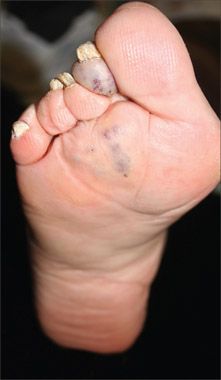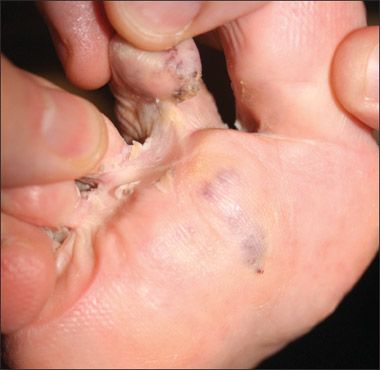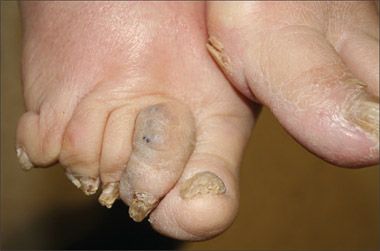- Clinical Technology
- Adult Immunization
- Hepatology
- Pediatric Immunization
- Screening
- Psychiatry
- Allergy
- Women's Health
- Cardiology
- Pediatrics
- Dermatology
- Endocrinology
- Pain Management
- Gastroenterology
- Infectious Disease
- Obesity Medicine
- Rheumatology
- Nephrology
- Neurology
- Pulmonology
An Old Woman With a Very Different Purple Toe
The plantar aspect of this toe shows purple nonuniform darkening that mimicked either a simple traumatic hematoma or the blue toe syndrome. More proximally, however, the solar aspect contained irregular dark-purple dots reminiscent of individual thrombosed venules, and in addition showed discontinuous purple zones more proximally in the part of the ray that lay within the body of the foot and that surely could not be imputed to any possible toe trauma or fracture nor to ischemia in the distribution of any single vessel. No purple area was warm or tender.

HISTORY
A 77-year-old woman on the behavioral health hospital unit for treatment of complications of dementia is seen urgently because nursing staff note blue second toe on right foot. Has had aortic problems including a resection of a segment with a free flap of atheroma, temporally associated with cognitive decline. Has atrial fibrillation and is taking aspirin monotherapy with no warfarin.
PHYSICAL EXAMINATION
Lethargic woman who cannot give cohesive answers to our queries. No skin lesions elsewhere including no livedo reticularis. Left dorsalis pedis pulse palpable; right barely palpable (feeble); neither foot is cold to the touch; both are nontender. Sole shows islands of similar purple discoloration. The purple toe is blanchable when capillary refill is tested. Attempt at Doppler assessment of perfusion is impaired by technical malfunction.
"WHAT'S YOUR DIAGNOSIS?"
Answer on Next Page
ANSWER: A NEW FORM OF PURPLE TOE

Figure 1 – Manual separation emphasizes dissemination of irregular purple discoloration onto sole just proximal to the blue toe. Prominent warty keratosis is seen on inferior surface of the second toe; keratinous debris is seen on third toe and in 1-cm-deep "trench" just before all 4 smaller toes separate from one another and from the distal sole.
The plantar aspect of this toe shows purple nonuniform darkening that mimicked either a simple traumatic hematoma or the blue toe syndrome.1-4 More proximally, however, the solar aspect contained irregular dark purple dots reminiscent of individual thrombosed venules, and in addition showed discontinuous purple zones more proximally in the part of the ray that lay within the body of the foot and that surely could not be imputed to any possible toe trauma or fracture (Figure 1) nor to ischemia in the distribution of any single vessel. No purple area was warm or tender.
We were highly puzzled, because many features fit for atheromatous embolism but the lesion morphology included some elements not described in that condition. It was considered urgent to decide whether any modulation of antithrombotic regimen was needed, and whether we needed to consult with a vascular surgeon. Making matters more complicated, her aortic procedure had been done in another part of the state, and had been undertaken for a flap of aortic intima and plaque that was thought to be a source of multiple small brain emboli and perhaps even an element in a progressive dementia.5,6 Clinical mini-strokes had ceased after this resection.
Her grown son, reached by telephone, informed us that the toe had "always been plum-colored" since an event in her childhood, and our concern about acute atheroembolism waned sharply. By next morning, the patient spontaneously became more cohesive and interactive. She told us that she had had "radium treatment" to the foot in early childhood, in the 1930s, and that the toe had been discolored ever since. Despite her dementia, she was highly descriptive and could answer compellingly that she was never told what condition was treated in this way; that she did not recall a deformity or lump beforehand; that the process, whatever it was, regressed or cleared after the radium but recurred subsequently, requiring surgery. All our efforts to identify a scar on the foot were unavailing.
SEEKING ANCIENT MEDICAL RECORDS
The patient recalled clearly that she had lived in Staten Island, New York, in childhood and received her radiation therapy in the city. At first she could not say whether this was in Manhattan. Then she remembered a hospital in her home borough. It had closed decades ago and been absorbed by another local hospital. We contacted the head of medical records at the latter to ask if any chart existed for a person of her name from the years in question. All records of that era had been destroyed. Thus, we could not determine indication, duration, or isotope.
We believed our patient though we acknowledge that others might not share this judgment. We recognize that radiation treatments were used in that period for many non-cancer conditions including goiter, acne, chronic tonsillitis, and doubtless others. It is also possible that a neoplasm was diagnosed clinically but that the requirement for histologic/cytologic confirmation, essential today in all but brainstem gliomas, was not so firmly established in the first third of the past century. We acknowledge that radiotherapeutic cure of a localized neoplasm may have occurred. We consider a noncancerous prospect more likely, and can speculate that a common wart might have been so treated if refractory to other measures; or that cosmetic considerations may have ruled if the toe were simply growing longer than desired, or out of alignment with its mates.
Today radium implants are employed in several closely defined cancers; 75 years ago, such caution was not recognized as essential. We need only consider how long shoe stores continued using fluoroscopy to determine footgear fit, to be reminded of the poor understanding of tissue injury and oncogenesis from ionizing radiation applied to the feet.
WHAT WOULD ATHEROEMBOLISM LOOK LIKE?
The blue toe carries a very long differential.1-4,7-9 For our purpose, ischemic or necrotic injury from atheroma impacting in a digital artery is the crucial consideration. Atheroembolism renders one or more (usually adjacent) digits blue-purple with or without eventual evolution into frank gangrene with black coagulative necrosis. One characteristic feature of atheromatous embolism at bedside is the coexistence of a toe that appears to have venous obstruction or incipient gangrene, and a preserved foot pulse. This feature is not pathognomonic, however, since other kinds of embolic debris can produce the same sequence, for example, in bacterial, fungal, or marantic endocarditis.
If livedo reticularis is seen, this speaks to ischemia often in a wider zone and is commonly present in atheroembolism syndrome. Vasculitis can produce the same manifestations, and so can diverse other disorders of the arterial and venous circulation, and multiple hypercoagulable syndromes.1,4,8
NONCUTANEOUS BEDSIDE CLUES
The state of the rest of the patient is pertinent: many patients with atheroemboli have abdominal aortic aneurysms as the source, so that if one is identified at bedside or by ultrasound, this enriches the sample. Any patient who has had recent instrumentation of the great arteries is at risk. This is true whether it was an endovascular test such as coronary angiography, or a therapeutic procedure such as coronary angioplasty, carotid endarterectomy, or abdominal aortic aneurysm repair (often with aortic cross-clamping). Finally, patients may develop spontaneous atheromatous embolization as has been noted since 1960.10
Besides the rare palpable and previously unrecognized abdominal aortic aneurysm, one can check on funduscopy for discernible yellow-orange refractile blobs at the bifurcation of arteries. These Hollenhorst plaques arise from atheroembolization11 and while they may come from a carotid atheroma, if they are bilateral, the proximal aorta becomes a major suspect.
Bizarre sites of involvement include the GI tract, manifested by pain and bleeding, and even acra such as the penis, ulcers of which can very rarely reflect atheromatous embolic injury.1,12
LABORATORY HELP
Test results can help secure or exclude the diagnosis of atheromatous emboli: renal failure of subacute onset is the best-known feature but occurs only if atheromatous emboli lodge in one or both kidneys. Eosinophilia is common but not specific, and the oft-recommended Hansel test for eosinophiluria1 is not available at all sites. Atheroembolic injury to the pancreas can cause elevation of amylase and lipase as well as the familiar clinical picture of pancreatitis13; and the liver enzymes can rise in this condition as in so many others.1,8
DID MEDICATION PRECIPITATE THIS?
Although even some recent reviews argue that the onset of atheroembolism is temporally and causatively connected to giving anticoagulants via denuding the fibrin cap over an ulcerated atheroma,1 data in several studies discount the impression that initiation of warfarin or heparin may augment risk, or even that thrombolytics play more than a rare role in initiating this sequence.3,14-17
OBSERVATION AND INFERENCES

Figure 2 – Dorsal view emphasizes positional fading of the purple toe. Tiny darker dots suggest minute thrombosed venules. Xerosis affects skin. Dystrophic yellow nails are prominent. Hammer-type deformity of right fifth toe is present. Crossover of purple toe with its lateral mate, the third toe, is less conspicuous than on plantar view in index image.
We did not change our management but continued to observe closely. The intensity of purple modulated irregularly at times from hour to hour (Figure 2) but did not fade over time. A similar variability was observed in another nonatheroembolic blue toe case4 wherein capillary-venous engorgement rendered the blue color more conspicuous with dependency than when the leg was at trunk level on the bed. Perhaps an analogous process was at work here. This phenomenon in atheroembolism reflects venous engorgement perhaps with an element of arterial insufficiency via loss of venous tone, just as in Buerger sign of the leg.17
Yet our patient's lesions were nonatheroembolic. Our best explanation for their source, though not for the postural variation, was remote radiation injury. We hypothesize that discoloration reflected endothelial damage and proliferation, resulting in tortuous microvasculature and thus variable red cell stasis; disordered epithelial growth (see Figure 1); and remote necrotic loss of substance associated with unfamiliar remodeling such that the metatarsal heads appear noncontiguous with the bases of the phalanges (see Figure 1). One could speculate that architecturally aberrant and disordered capillary proliferation followed the known ischemic injury that radiation causes, analogous to the response to endogenous ischemia in proliferative diabetic retinopathy.
We marveled once again at how our patients’ bodies become, besides all their other functions, the museum repositories of the history of our profession, for good and ill; and at the co-occurrence of a perfect background on which atheroembolic blue toes might arise, with the actuality of a cause not previously described, to our knowledge, in the medical literature.
Schneiderman H, Mbewe A. An old woman with pseudo-atheroemboli in a discolored 7-decade-old medical footprint. Consultant. 2010;50:259-263.
References:
REFERENCES:1. Hirschmann JV, Raugi GJ. Blue (or purple) toe syndrome. J Am Acad Dermatol. 2009;60:1-20; quiz 21-22.
2. Hendel RC, Cuenoud HF, Giansiracusa DF, Alpert JS. Multiple cholesterol emboli syndrome. Arch Intern Med. 1989;149:2371-2374.
3. Hyman BT, Landas SK, Ashman RF, et al. Warfarin-related purple toes syndrome and cholesterol microembolization. Am J Med. 1987;82:1233-1237.
4. Schneiderman H. Blue toe syndrome without emboli. Consultant. 1994;34:1037-1038.
5. Tunick PA, Nayar AC, Goodkin GM, et al. Effect of treatment on the incidence of stroke and other emboli in 519 patients with severe thoracic aortic plaque. Am J Cardiol. 2002;90:1320-1325.
6. Rapp JH, Pan XM, Neumann M, et al. Microemboli composed of cholesterol crystals disrupt the blood-brain barrier and reduce cognition. Stroke. 2008;39:2354-2361.
7. Schneiderman H. Atheromatous emboli and livedo. Consultant. October 1992;32:73-76.
8. Darsee JR. Cholesterol embolism: the great masquerader. South Med J. 1979;72:174-180.
9. Yucel AE, Kart-Koseoglu H, Demirhan B, Ozdemir FN. Cholesterol crystal embolization mimicking vasculitis: success with corticosteroid and cyclophosphamide therapy in two cases. Rheumatol Int. 2006;26:454-460.
10. Gore I, Collins DP. Spontaneous atheromatous embolization. Review of the literature and a report of 16 additional cases. Am J Clin Pathol. 1960;33:416-426.
11. Olofinboba KA, Schneiderman H. Hollenhorst plaques: atheromatous emboli to the retina. Consultant. 2001;41:1527-1529.
12. Bhasin N, Berridge DC, Scott DJ, et al. Penile ulcer: an unusual presentation of cholesterol emboli. Eur J Vasc Endovasc Surg. 2004;27:447-448.
13. Schneiderman H. A neglected etiology: atheromatous embolism. Mount Sinai J Med. 1986;53:578.
14. Nevelsteen A, Kutten M, Lacroix H, Suy R. Oral anticoagulant therapy: a precipitating factor in the pathogenesis of cholesterol embolization? Acta Chir Belg. 1992;92:33-36.
15. Queen M, Biem HJ, Moe GW, Sugar L. Development of cholesterol embolization syndrome after intravenous streptokinase for acute myocardial infarction. Am J Cardiol. 1990;65:1042-1043.
16. Anonymous. Transesophageal echocardiographic correlates of thromboembolism in high-risk patients with nonvalvular atrial fibrillation. The Stroke Prevention in Atrial Fibrillation Investigators Committee on Echocardiography. Ann Intern Med. 1998;128:639-647.
17. Schneiderman H. Peripheral arterial insufficiency manifest by positive Buerger's test. Consultant. 2001;41:1442-1448.
